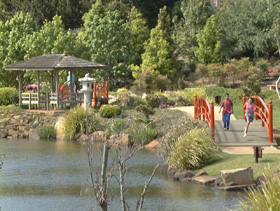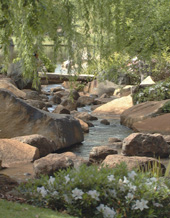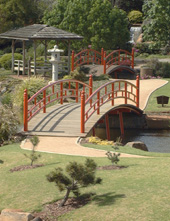

(Ju-Longevity, Raku - to enjoy, En - a place for public recreation)
One of the most peaceful and beautiful parks in Toowoomba is the University's Japanese Garden.
Located on the northern side of the campus, on a 4.5 hectare
site, it is Australia's largest and most traditionally designed Japanese stroll garden. |
 |

|
Japanese gardens emphasise the use of rocks to create three dimensional pictures in stone. All the large rocks in Ju Raku En were accurately placed by the designer of the garden, Professor Kinsaku Nakane of Kyoto, so as to appear naturally dispersed in a random way. Ju Raku is more than just a group of rocks stitched together by water and artificially created hills and forests. It is actually a presentation of Buddhist paradise with the celestial sea (the lake) lapping the rocky shores of the three islands where the immortals are said to dwell. The material world is the outer edge of the lake and a symbolic journal to paradise may be made by crossing one of the four bridges to the islands. |
|
The master plan for Ju Raku En and the design for the community building and tea house were prepared
in Japan after site analysis and intensive background studies by staff of the Nakane Garden Research.
Construction commenced in 1983 after 3 years of planning. Ju Raku En was opened on 21 April 1989 by
Mr Yoshiharu Araki from the Brisbane Consul-General of Japan, but it is still a comparatively young
garden and it will take many years for it to be considered complete. |
 |
 |
It is estimated that over 50,000 per year visit the gardens. Most visitors stroll through the garden
or relax on the seat near the Dry Garden; it is not uncommon to see an artist quietly painting a scene
or children feeding bread to the fish or birds, which include swans, ducks, geese and smaller natives.
It is a popular venue for weddings: spring weddings are often held under the mass of lilac blossoms hanging from the Wisteria Pergola, while other couples choose to be married in front of the waterfall or under the Viewing Pavilion on one of the islands. |
|
The Garden is open daily from 7am to 7pm and admission is free. The site is jointly owned by USQ and the Toowoomba City Council. Access to the Gardens is from the University Ring Road (northern side).
We hope you enjoy your visit to the garden or will be able to visit it soon! |
